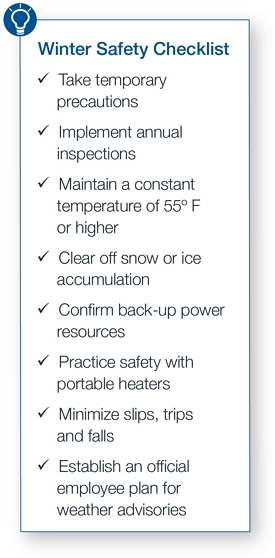Plan ahead to minimize property damage and liability risks this winter.
For businesses all across North America, the onset of winter brings increased liability and the potential for property damage or business interruption due to severe weather and frigid temperatures.
According to Munich RE, winter storms in the U.S. caused an estimated $2.3 billion in insured losses in 2014, up from $1.9 billion in 2013.[1] The 11 winter storms and cold waves during the first half of 2015 cost $2.9 million in insured losses year to date.[1]
“Winter weather can be damaging across the board, from commercial to industrial to residential buildings,” said Christopher Dunlap, MS, ABCP, ARM, CFPS, AVP / risk consultant, Risk Services Division, HUB International. “It’s important to be cognizant of some common causes. For example, when a building isn’t well
insulated, or there’s a sprinkler pipe near an exterior wall, pipes can easily freeze or burst during extremely cold weather, causing water damage to the building and equipment.”
So, what can you do to minimize your risk and keep employees and customers safe this winter? Plan ahead.
“Ask yourself: What are my biggest risks and how can I mitigate them?” suggests David Laks, P. Eng., CFPS, RRC, ARM, vice president, Risk Control Services Manager, Risk Services Division, HUB International. “You should pre-plan as much as possible to ensure continued uptime and safe conditions for
all.”
Plan now for later
Winter weather hazards can cause property damage, mobile equipment or vehicle damage, business disruptions and other headaches for business owners. To minimize property losses and claims, follow this safety checklist before the temps start to drop.
 Take temporary precautions. Temporary heat
can be brought into rooms that are particularly cold or at a greater risk for freezing. Temperature-sensing cables can be tied to interior sprinklers that set off an alarm when a certain temperature threshold is crossed. Additionally, extra pipe insulation can be added in high-risk areas for very little cost.
Take temporary precautions. Temporary heat
can be brought into rooms that are particularly cold or at a greater risk for freezing. Temperature-sensing cables can be tied to interior sprinklers that set off an alarm when a certain temperature threshold is crossed. Additionally, extra pipe insulation can be added in high-risk areas for very little cost. - Annual inspections. Boilers and roofs should be inspected for potential defects and leaks at least annually, preferably just before the winter season and again after a major storm.
- Maintain temps. To prevent frozen pipes, keep thermostats at 55°F or higher, even in vacant areas. This includes empty stores in a strip mall, vacant apartments in a multi-family building or wings of a building that are unoccupied.
- Clear off snow or ice accumulation. Snow loading on a roof can cause deflection and sagging of the roof structure, damage and in some cases, roof collapse. Ice damming, or the build up of ice on the eave and soffit area of a roof, can cause chunks to break off and fall, or when melting,
can cause water to seep into the building through the roof system. Depending on the amount of snowfall or other winter conditions, put preventive measures in place, like pre-arranged snow removal for heavy accumulations, rakes on sloped roofs to reduce the likelihood of snow/ice from falling off and damaging
property or injuring personnel. Block off access under areas where potentially dangerous situations exist.
- Make frequent
use of your water supply. Flowing water often breaks up ice below freezing. When outside temperatures remain below freezing, it's less expensive to run your faucet regularly than to repair a frozen or burst pipe.
- Backup the backup power. A generator will only work if it has been maintained properly. Make sure you store the appropriate amount of fuel required for backup power to function as needed.
- Practice
safety with portable heaters. The National Fire Protection Association reports that space heaters - whether portable or stationary - account for as much as a third of heating fires each year. This can be the result of heaters placed near combustibles, heaters not
properly plugged in or those lacking adequate safety features. Require employees using portable heaters to purchase only those with certification from an independent testing laboratory and ask that they gain approval from a supervisor or facility manager before using it. At that time, have a conversation about proper
placement and care for the heater in the office.
- Have an official plan. Have a winter advisory plan that specifies when early dismissal or office closure are appropriate, and should the need arise, who will make the call and how the information will be disseminated to staff.
Understand
your insurance coverage
Having the right property and casualty coverage in place will help ensure that you are protected in the event of property damage or accident. You should also understand your liability risks related to contractors and vendors who work on your premises.
Contact your HUB broker to determine the right insurance options for your business.
[1] Insurance Information Institute.